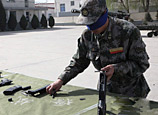
TORONTO, May 1 (Xinhua) -- The architectural beauty of Canada's Chinatown gateway arches was the focus of Canada Post's new special stamp edition, which was used to highlight and celebrate the longstanding Chinese-Canadian heritage.
Issued on Wednesday in Toronto, the Gates of Chinatown series put the overlooked masterpieces back in the limelight.
The stamps feature eight Chinatown arches, also known as paifang in Mandarin, in eight cities -- Toronto, Mississauga, Victoria, Vancouver, Edmonton, Winnipeg, Ottawa and Montreal.
Launched to commemorate the country's Asian Heritage Month, a celebration on the beauty and wisdom of various Asian cultures, they were aimed at honoring and drawing attention to the many contributions that Chinese-Canadians have made to the country over the decades, Canada Post's retail business manager Danny Kotsopoulos said.
"We had a lot of Chinese over the years and decades who were involved in helping build Canada," said Kotsopoulos. "In terms of being symbolic of new Asian-Canadians, bringing a bit of their history and their work and integrating it with the Canadian heritage as well, it's a nice way to be responsive to the community."
Each Chinese gate in the series is interpreted by eight different artists. Albert Ng, the illustrator who worked on the gateway of the Mississauga Chinese Center, was on hand to sign stamps for collectors.
The making of the stamps has taken two years.
Albert Ng took more than 500 photos for reference, and made at least 50 to 60 sketches just to perfect his own interpretation of the gate.
The most challenging part, Albert Ng said, was trying to simplify it enough to fit into a stamp, while also maintaining the most integral characteristics of the gate.
These paifangs, which were made out of wood or stone to separate subdivisions in Chinese cities, have long lost its role but remained as monuments.
The gateway for the Mississauga Chinese Center, a Chinese mall which opened in 1987, measures roughly 43 feet tall. The structure was built with 17,000 cubic meters of timber, and the most impressive part was that not a single nail was used in its construction. Instead, they used wooden studs to build the gate to demonstrate the high building technique of Chinese architecture.
With so much history and details attached to the structure, Albert Ng had to figure out how he wanted to depict the architectural masterpiece in his stamp.
"This is very unique, the Chinatown gate with the dragon wall behind it, so I wanted to show it," he said. "I wanted to show the environment, the surrounding area of the Chinatown gate, show the dragon wall. And the characteristic of this Chinatown gate is very similar to those I saw in Beijing, so I wanted to use that expression."
Each of the eight gates on the stamps depicted distinct elements and stories behind them.
Victoria's gates honors Chinese-Canadian soldiers from the Second World War, while the Millennium Gate in Vancouver draws inspiration from the Inner City Gates of 19th and 20th century Beijing, and Edmonton's gate marks the relationship with Chinese sister city Harbin.
Albert Ng said the series have a significant meaning to each and every Chinese-Canadian like himself.
"It represents the community," he said. "I think that's very important for each city ... especially now we have a series of stamps, it just raises the recognition of the Chinese-Canadians in Canada, and also shows their contribution to Canada."
Stamp collector Helen Ho, who immigrated to Canada from Hong Kong more than 40 years ago, was one of dozens who lined up on Wednesday to get her hands on the new stamps.
"When we first came, there were not a lot of Chinese people around, and our kids were bullied in school, but now you see Chinese people being honored for their beautiful designs, so we bought it to remember this moment."
"The aesthetics is just pretty visually to look at, and symbolically, a new start, a new gateway, a new beginning," Susana Albuquerque, another stamp collector said.
Canada's very first Chinatown was established in Victoria, B.C. back in 1858 when a large influx of Chinese laborers immigrated into the country to build the Canadian Pacific Railway.
The Victoria Chinatown grew steadily over the years, becoming a thriving hub for Chinese-Canadians. It reached its peak in 1911, when it occupied an area of about six city blocks in the north end of downtown Victoria.
But nowadays, Canada's Chinatowns are attracting fewer and fewer new immigrants to visit, and they're also losing its appeal to business owners, according to Lai, a Hong Kong immigrant who is also known as the Father of Chinatowns in Canada.
Using Toronto as a reference, he noted that the best Chinese restaurants, and even associations of the Chinese community, are all missing from the city's Chinatown.
"The current situation of Chinatown is OK, but the preservation of Chinatown is a big problem," Lai said, concerned about whether the Chinatowns can exist in 30 or 40 years.
"The gates are landmarks of Chinatown and it's important to preserve them. The launch of the series is a good way to preserve the gates," he added.
















 Matchmaking websites crack down on user fraud
Matchmaking websites crack down on user fraud


![]()
